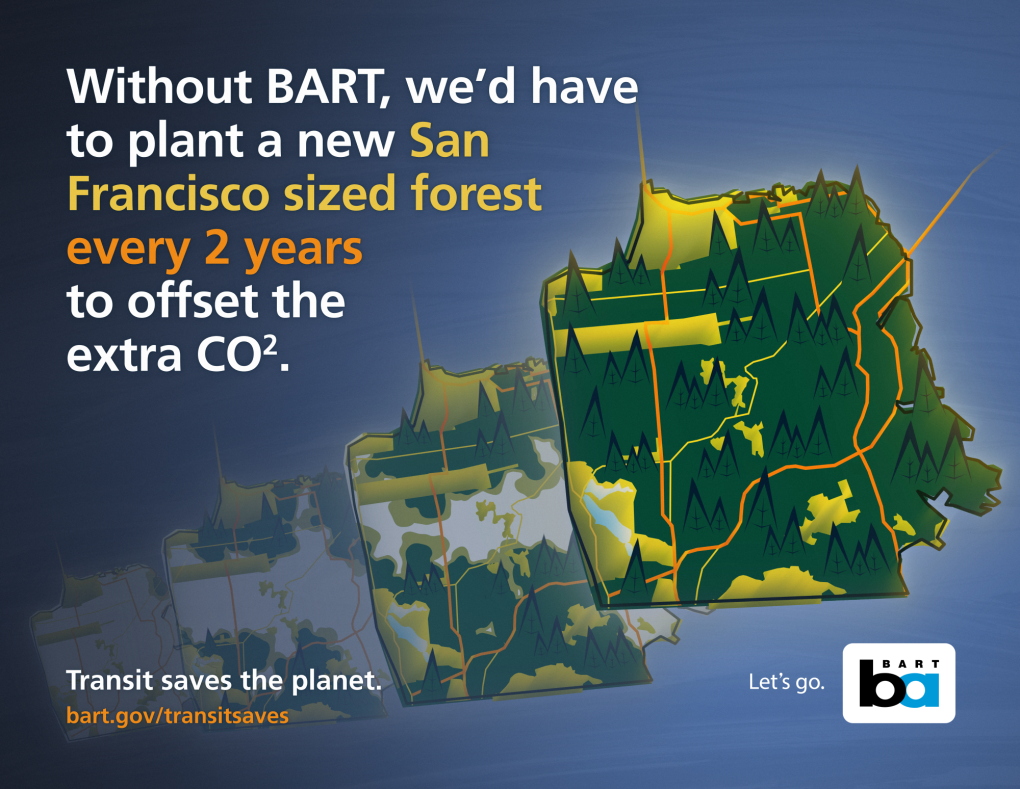Search Results
Transit is punk: Kamala Parks went from cofounding 924 Gilman Street to urban planning at BART
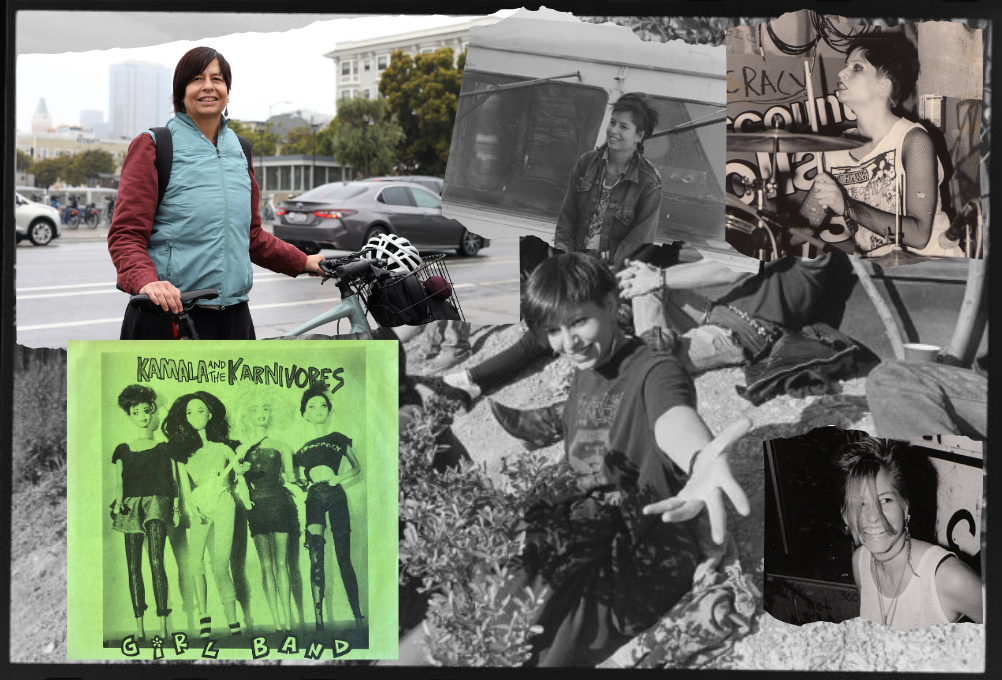
BART transportation planner Kamala Parks is pictured in photos from the 1980s to present. Black and white photos courtesy of Murray Bowles.
“Transit is punk,” according to Kamala Parks, Principal Station Planner at BART.
Parks, of all people, would know.
The transportation planner was a formative force in the Bay Area punk scene, particularly from the mid-1980s through the 1990s. This was an inflection point for punk, with bands like Green Day, Neurosis, and the Offspring making the leap from tiny scene venues to sold-out concert halls and stadiums.
These iconic bands have at least two things in common. All of them are graduates of one of the most legendary punk venues of all time – 924 Gilman Street in Berkeley, often called Gilman by the punk community – and Parks played an early role in their success.
Parks cofounded 924 Gilman – an all ages, collectively organized nonprofit music venue still going strong today – in 1986 as part of the MaximumRockNRoll ‘zine and collective spearheaded by Tim Yohannan. Getting the venue off the ground required wading through the leasing and zoning process, attending city hall meetings, and speaking with officials. The experience was Parks very first taste of urban planning, and it would come to serve her professionally many years later.
So, Green Day...well, Parks was their first-ever band manager. Neurosis and the Offspring? She booked their first two national tours. The Offspring were the first to bring her on tour as their road manager, the first of many tour managing roles she did for multiple bands.
When she wasn’t uplifting other bands, Parks was drumming for Cringer, the Gr’ups, Naked Aggression, and the aptly named Kamala & The Karnivores. If you saw the recent film Freaky Tales, you might have spotted a Kamala & The Karnivores patch stitched on the back of star Ji-young Yoo’s jacket.
“Parks is a networker of East Bay punk,” a 2017 profile of her proclaimed, noting that she unknowingly designed “what would become a blueprint for DIY scenes worldwide.”
A recent photo of Kamala Parks at Lake Merritt Station.
In sum, Parks is a punk legend.
Many of her BART coworkers have absolutely no idea. Rather, they know Parks from her planning efforts, like her work on BART's Transit-Oriented Development, her leadership on projects like Safe Trips to BART, and her role as the Station Area Planner from Orinda to Antioch.
“Some folks are surprised I’m a punk rocker. They say I don’t look like one,” Parks said. “But I don’t have to look it. It’s my people, it’s a way of being in the world.”
And transit, she said, is decidedly punk.
"When you’re a punk, you love efficiency, sustainability, democracy,” she said. “Transit fulfills all these things.”
Parks brings the spirit of punk to the workplace. When you’re a punk, if there’s an obstacle, you find a way to work around it. Low on resources? Figure it out. And most importantly, never take anything at face value, always question the status quo.
“As a planner, I’m constantly asking myself things like, is there a reason this is the way it is? Can we revisit this? Reimagine it?"
It’s a helpful vantage point for someone in her line of work. Crudely put, planners assess the present to construct the future. There’s a synergy with planning and punk, the music and movement known for holding a magnifying glass to the world and asking, “Why does it have to be like that?”
“You don’t buy into the mainstream narrative as much when you’re a punk,” Parks said.
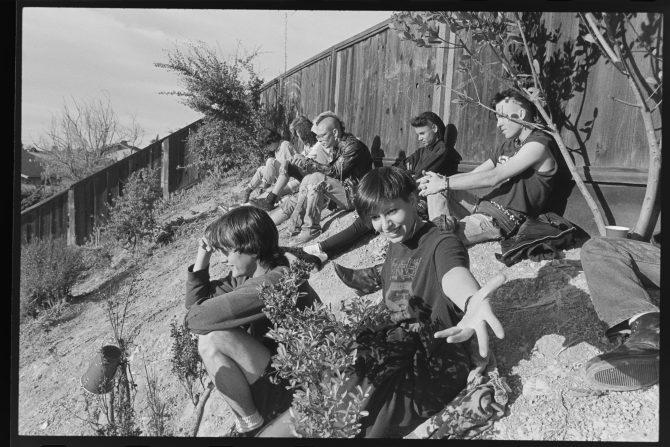
Kamala Parks, pictured front right, circa late 1980s/early 1990s at a backyard gig in Pinole. Credit: Murray Bowles
Parks’ career was the least of her concerns as a free-spirited teenager growing up in Berkeley.
“I was not exactly an ambitious kid,” she said. “When I was young, I wanted to be a cashier. They seemed to know everything – the price of an apple, the cost of a can of corn. This was way before the scanner. You had to enter all the prices manually! But as soon as the scanner rolled out, my dream was quashed.”
Parks described her teenage years as “directionless.” She was a mediocre student at Berkeley High School, didn’t have a lot of friends or grand ambitions.
What she did have was music. Parks recalled the summer before 11th grade when her dad left her in the care of one of his students from Diablo Valley College while he was on sabbatical in Europe. He gave the college kid $500 for Parks’ care and keeping. Not long after dad hit the road, the young woman and her boyfriend decided to spend the summer in Mexico, leaving Parks to fend for herself.
“I came home from school one day and no one was home. But she had left the money on the table,” Parks recalled. “I immediately went to Telegraph [Avenue] and bought records and a Walkman. Needless to say, I spent that $500 in a very short amount of time.”
“Music,” she went on, “was the thing that saved me as a kid. I cared about it so much, and I was beginning to have this incredible community in the punk scene full of very smart, supportive people.”
But she had a bone to pick with Berkeley: All the cool live music venues in town were 21 and over. So 17-year-old Parks wrote a letter to the city council more or less asking, “What gives? There’s nothing for young people to do in this city. Why aren’t there any all-ages music venues?”
That was the genesis of the idea that would eventually give birth to 924 Gilman.

Left: Kamala and The Karnivores Girl Band EP, originally released on Lookout Records in 1989. Right: Kamala and The Karnivores second record, Vanity Project, released in 2018.
Flash forwards a couple of years, and Parks and her cofounders are sitting in a city council meeting, ready to make the case for their venue.
“The lightbulb did not go off that this sort of work was what I should be doing, not at all,” Parks said of urban planning. “I thought the city was being silly, asking things like, ‘Where will people park?’ And I said, ‘Parking? Who cares about parking!’”
Parks argued that the industrial area already had ample street parking, and most people would carpool or use transit. The majority of her friends didn’t own cars.
“We ended up rezoning the building for an entertainment permit,” she said. “At the time, it seemed like a bunch of hooey that we couldn’t have our club immediately. There was so much hoop jumping. I was definitely not inspired to pursue urban planning.”
But there was a lesson in all of it.
“The wonderful thing about youth is you’re not weighed down by past experiences that tell you what is and isn’t possible,” she said. “Fresh, questioning eyes are an asset."
After Parks “barely” graduated high school, she worked at the Peet’s Coffee and Tea warehouse and other blue collar or service jobs to prioritize and fund the unpaid efforts of touring, booking tours and shows, playing music, and volunteering at Gilman. However, part-time studying at community colleges eventually led to her getting a math degree from a four-year college. Unsure of what to do next, she got her teaching credential.
“Teaching was brutal,” she said. “I have so much respect for teachers. That is the hardest job I’ve ever had.”
Before getting the credential, Parks had taken a few urban studies classes at San Francisco State and realized, “This is it! This is what I want to do!”
But Parks wasn’t sure she wanted to spend more time in school to get a second bachelor's degree. And though she loved the field, she was sick of being poor and just wanted to start working.
Her stint as a teacher lasted about two years, and Parks took some time to regroup working as a project assistant at a construction management company. While there, she discovered the urban studies flame still flickered inside her.
Parks eventually decided to enroll in a grueling program at UC Berkeley, where she got two master’s degrees, one in civil engineering and one in city and regional planning.
She went on to work in consulting and for the City of Berkeley. BART, however, was always the dream.
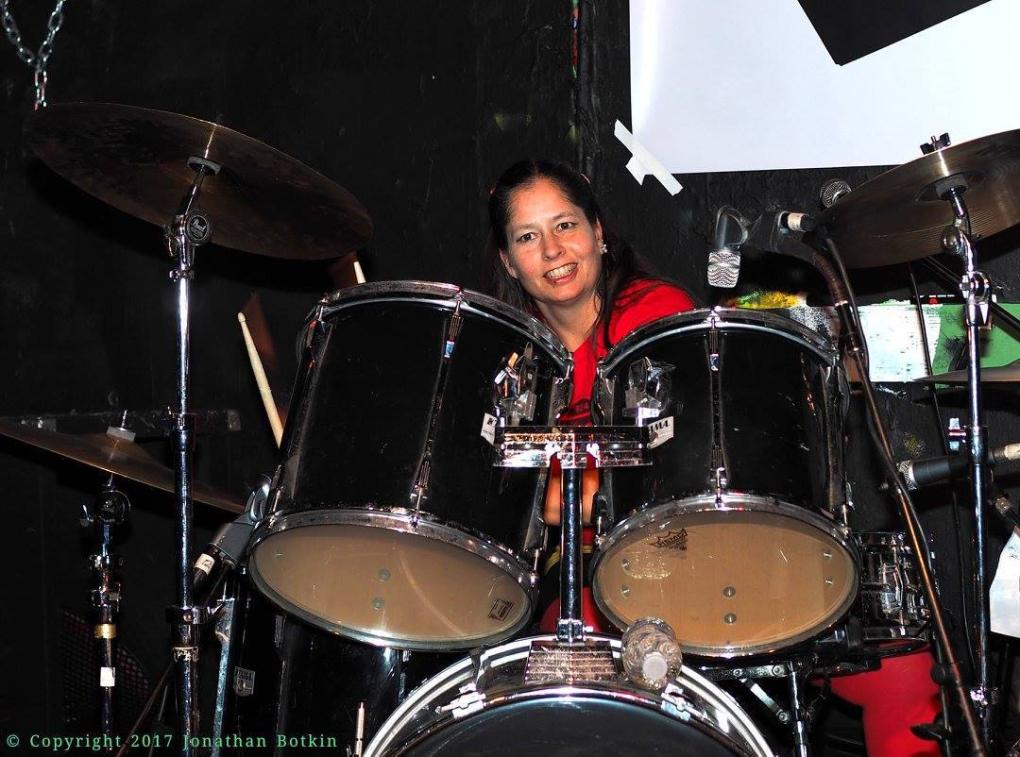
Kamala drumming with Kamala and The Karnivores in 2017. Credit: Jonathan Botkin.
“BART has a very special place in my heart and has been crucial to many aspects of my life,” she said.
In 2018, after applying for years to any position she was qualified for, Parks finally got the call that she was selected for a planner role.
She's never looked back.
“There is rarely a day I wake up and say, ‘I don’t feel like going to work today,’” she said. “I just feel so lucky.”
Parks wishes she had discovered transportation planning earlier. Growing up, she never thought of it as a profession or really knew that the field existed at all. Now, she’s doing her part to amend that for the next generation.
“A few years ago, I went back to Berkeley High School for a lunch session called ‘How did you get that cool job?’ where I met with seniors and talked about what I do,” she said. “I wish someone had done that for me!”
Through it all, the punk community has remained a constant force in her life. And she’s still involved with 924 Gilman, not as a booker or board member anymore, but as an attendee and an as-needed advisor. To this day, the venue hosts more than 20 nights of performances a month, often with bills consisting of five to six bands.
Parks left an indelible mark on the Bay Area punk scene, and now, as a planner for BART, she gets to leave a different sort of legacy behind.
"Planners come up with the ideas that spur improvements to connect communities,” she said.
And that’s a through line in her life. Whether its music or street improvements, she wants more than anything to facilitate connections– to other people and to the spaces in which they gather.
Join BART's General Manager on a ride-along and happy hour with Transit CEOs on 9/29/23
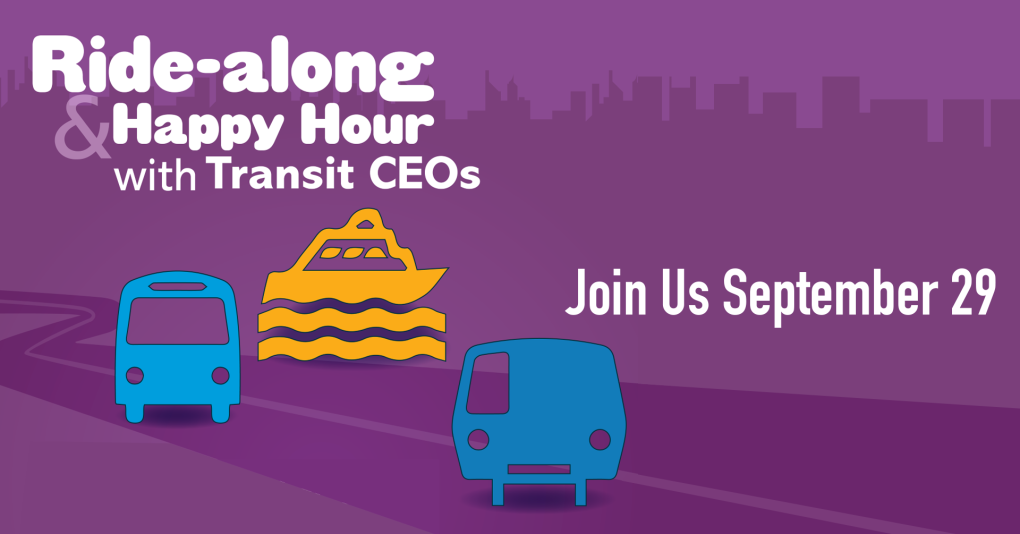
In celebration of Transit Month 2023, the Bay Area transit agencies and the Metropolitan Transportation Commission (MTC) are hosting a third “All Aboard with Transit CEOs,” a ride-along and social event giving the public a chance to ride with and meet regional transit leaders. The event is also an opportunity for transit leaders to call for on-going financial support for transit operations and to showcase the coordination happening among agencies to improve the rider experience in the Bay Area.
The event is Friday, September 29, 2023, starting at 5pm at the Palo Alto Caltrain Station/Transit Center. The Palo Alto Transit Center is an intermodal transit center served by Caltrain, SamTrans, VTA, Dumbarton Express, the Stanford University Marguerite Shuttle and several local shuttle services.
Trip details:
Before 5pm: The public and Transit CEOs will come from different transit systems, connecting with the public along their route to the Palo Alto Caltrain Station/Transit Center.
5pm: The public and Transit CEOs meet at the Palo Alto Transit Center (Caltrain Northbound Platform to San Francisco) for photos and mingling.
5:19pm – Everyone boards Caltrain #709 for an onboard Happy Hour (BYOB)
5:44pm – Train arrives at Millbrae Transit Center (100 California Drive, Millbrae)
6:03pm – The Ride-a-long ends as the train arrives at San Francisco Caltrain Station (700 4th Street, San Francisco)
Members of the public and the media are invited to ride for the full or partial journey. This event is a great opportunity for the public to chat with CEOs about transit service and transit career opportunities. Follow on social media for real time updates of the CEOs journey.
Participating CEOs include: SamTrans (April Chan), Caltrain (Michelle Bouchard), VTA (Carolyn Gonot), MUNI (Jeff Tumlin), BART (Bob Powers), WETA/SF Bay Ferry (Seamus Murphy), County Connection (Bill Churchill), and LAVTA/Wheels (Christy Wegener).
The CEOs will be taking transit to the Palo Alto Caltrain Station and posting on social media using the #TransitMonth hash tag. Several CEOs will announce their routes to get to Palo Alto Transit Center if you want to join them on the journey.
BART General Manager Bob Powers will take BART's Red Line to Millbrae leaving 19th Street Station at 2:57pm and transfer to Caltrain at 4:02pm
SamTrans CEO April Chan will ride ECR leaving San Carlos Ave / El Camino Street at 4pm
Caltrain Executive Director Michelle Bouchard will ride Caltrain #410 leaving San Carlos Station at 4:48pm
VTA CEO Carolyn Gonot will ride the VTA Blue Line from River Oaks Station leaving at 3:45, changing trains at Baypointe to the 4 pm Orange Line to Mountain View. Then Caltrain #309 departing Mountain View at 4:40 pm
Saturday, July 26: Oakland Roots to celebrate BART with special match, station parade, and Kamaiyah halftime show
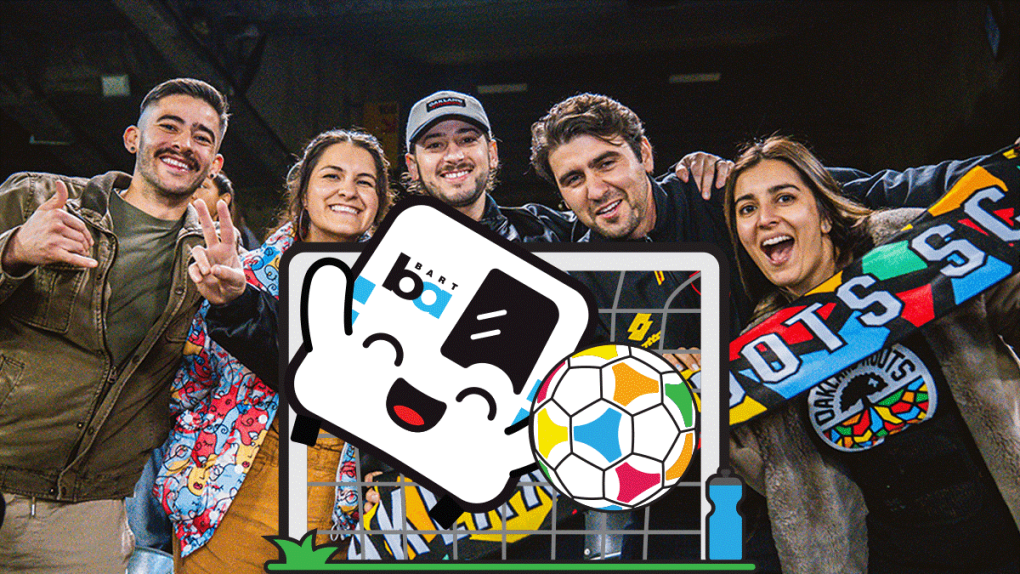
Meet BART on the pitch for a special Oakland Roots match celebrating transit at the Oakland Coliseum on Saturday, July 26.
Before kickoff at 1pm, BART invites you to join a fan parade from Coliseum Station across the bridge to the stadium. To get in on the fun, meet BART staff at the station near the bridge between noon and 12:30pm. The parade will begin at 12:30pm.
The Roots are also offering a special discoount. Use the promo code BART to save 20% on Roots tickets for this and all other Roots games.
Purchase discounted tickets to the match here.
The BART Title Game match will be played against Orange County SC at the Oakland Coliseum, just steps from BART’s Coliseum Station. The Oakland Roots compete in the United Soccer League (USL) Championship, which features 24 teams across the United States.
Similar to the Oakland Ballers’ recent Public Transit Night, the Roots’ BART Title Game will feature BART throughout the afternoon. Planned BART activities include the fan parade, photos with the BARTmobile, and surprises. And did we mention Oakland rapper and singer Kamaiyah is playing the BART Halftime show?
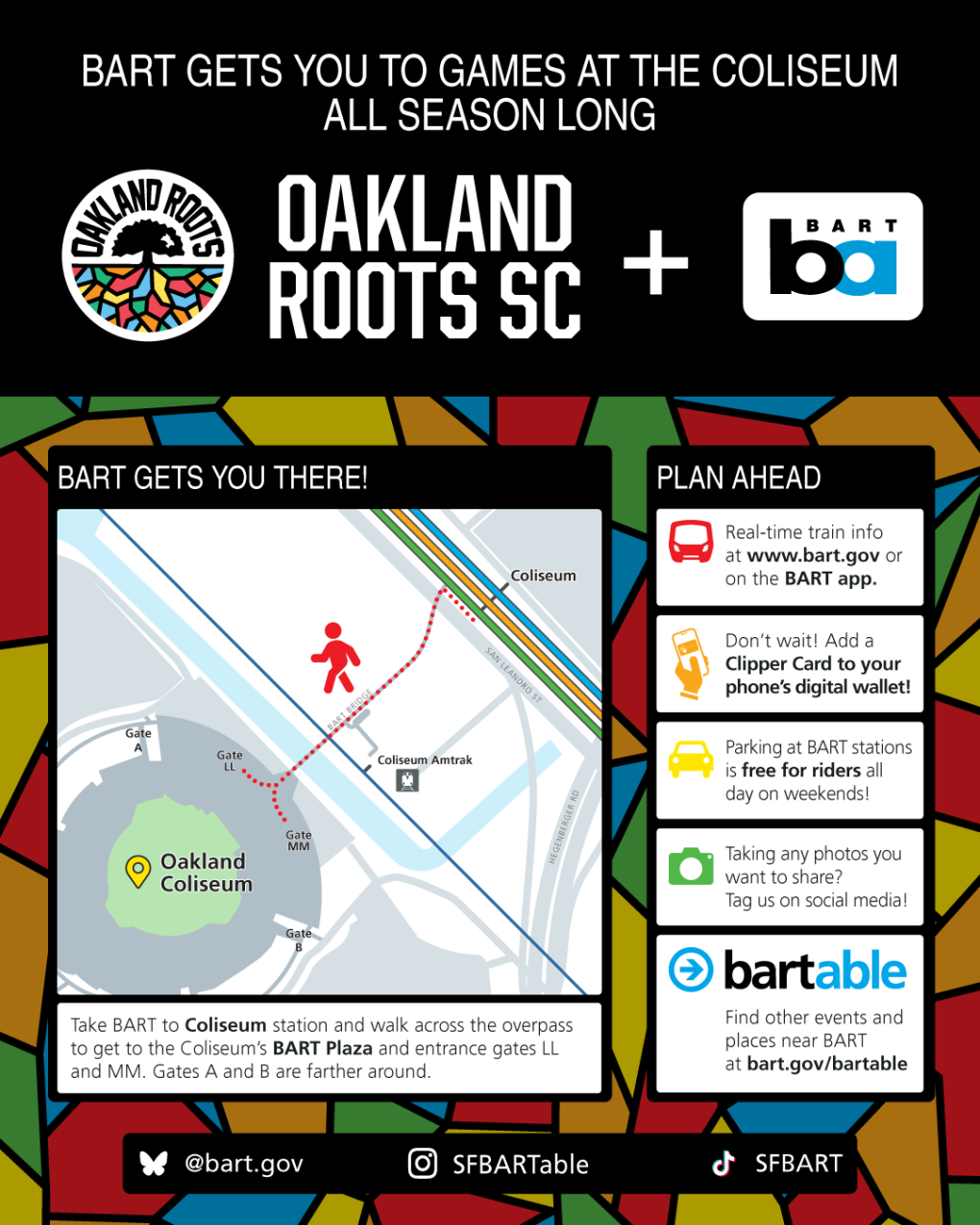
Driving ridership through sports partnerships
The BART Title Game is part of BART Marketing’s efforts to boost ridership and foster stronger ties with local communities through strategic partnerships. BART partners with over 250 local organizations annually, helping to significantly expand the reach of our messaging. These partnerships come at no cost to BART and promote that taking BART is fun, in addition to being convenient, inexpensive, and environmentally friendly.
Since the pandemic, ridership on nights and weekends is growing faster than commute ridership. While people may not be going into the office as often as they used to, they are going to games, shows, museums, and other fun events that can only be experienced in person. Our partnerships lean into this.
Discover more BARTable fun at bart.gov/bartable and check out our Rider Guides page with tips for how to get to local sports and entertainment venues by BART.
Transit Saves the Planet: BART celebrates Earth Day with educational marketing campaign and collaborative community tree planting
BART's new Transit Saves 2024 campaign art is featured in the slideshow above.
Earth Day is an international event held annually on April 22 to celebrate sustainability and raise awareness about environmental protection. At BART, it is an important opportunity for us to reflect on the many challenges our planet faces, including climate change, deforestation, and environmental pollution, as well as the ways we can be part of the solution.
BART takes special care to acknowledge Earth Day every year because sustainability is a core value of our organization. On past Earth Days, we interviewed riders on trains about their carbon footprints; we created a map highlighting some of the creatures and green features around the BART system; we even put together a BART-themed Earth Day quiz.
This year, we’re celebrating Earth Day with a new educational marketing campaign that highlights some of the environmental benefits of taking BART. The campaign is now live on the digital screens in select stations and will also occupy the ad spaces in stations and trains. You can see the art in the slideshow below.
Additionally, this year BART collaborated with the Oakland Parks and Recreation Foundation and Trees for Oakland to host a tree planting event. The volunteers, which included many BART employees, planted more than 100 native trees at the Martin Luther King Jr. Regional Shoreline in Oakland.
Public transportation is one of the greenest ways to get around, and on Earth Day, BART celebrates that. Learn more about the campaign and the tree planting below.
Happy Earth Day!
BART launches second edition of Transit Saves marketing campaign
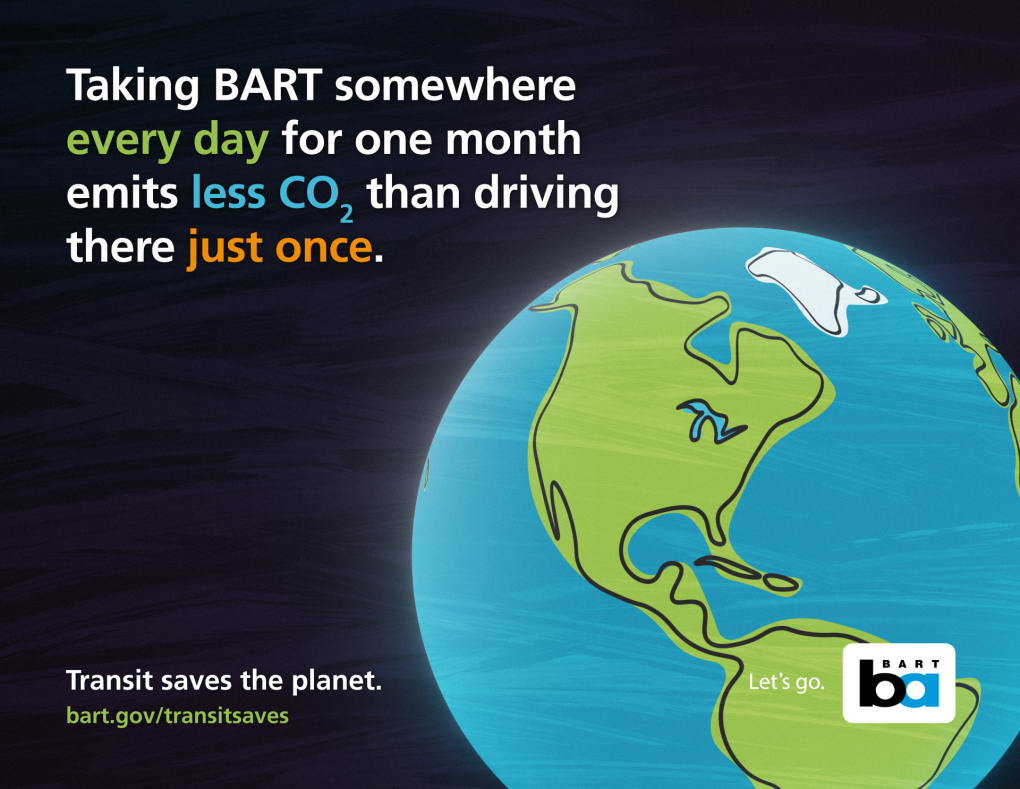
A panel from Transit Saves 2023.
Today, BART is thrilled to launch the second edition of our Transit Saves marketing campaign with three novel art concepts. We debuted Transit Saves in 2023 to highlight the many reasons public transportation enhances our communities, but there were simply too many ways “transit saves” to include in a single campaign. So, we created another one.
You can view the new art, which includes updated data from our forthcoming Role in the Region Study, in the above slideshow. As of today, you will begin to see the art around the Bay Area, including in the ad spaces on trains and in stations. Animated versions of the art will be rotating on the digital advertising screens in some BART stations as well.
Check out our Transit Saves webpage for some quick facts about BART’s importance to the region (environmentally and otherwise) and to view our methodology.
BART collaborates with local organizations for tree planting event
BART is committed to bringing the community together to safeguard our local environment.
For Earth Day, BART’s Sustainability Department organized a tree planting event at the Martin Luther King Jr. Regional Shoreline in Oakland on Saturday, April 20, in collaboration with the Oakland Parks and Recreation Foundation and Trees for Oakland. BART employees, their loved ones, BART District 4 Director Robert Raburn and his wife, Pat, and other members of the community came together to plant 100 trees, including Monterey cypress, Catalina ironwood, hollyleaf cherry, flannel bush, and various types of oak. These trees are native, climate adapted and/or shoreline adapted, and will help sequester carbon that would otherwise contribute to climate change. As you can see in the above Transit Saves art, if we didn’t have BART, we’d have to plant a San Francisco-sized forest every 2 years to offset the extra CO2 emissions. The trees we planted will also provide habitat for animal species and shade for humans and animals seeking relief from heat.
“It was such a pleasure to see everyone out here doing work that helps fight against climate change,” said BART’s Principal Sustainability Analyst, Michael Cox. “We are all public servants at BART, and we take extra pride in being able to help our community with events like this.”
Added Alex Pinto, the Community Greening Program Manager at Oakland Parks and Recreation Foundation: “I see Earth Day as an important opportunity for us to connect with nature in new ways and learn about the natural world. Putting away our electronics and placing our hands in the soil can be a relaxing and gratifying experience.”
Please join us this Earth Day by learning about the role transit plays in protecting the Bay Area and our planet. Additional information about BART's ongoing sustainability efforts can be found here. And of course, consider taking BART to your destination whenever possible!
BART's Impact: How Pleasant Hill/Contra Costa Centre Station supports a city’s businesses, residents, and tourists
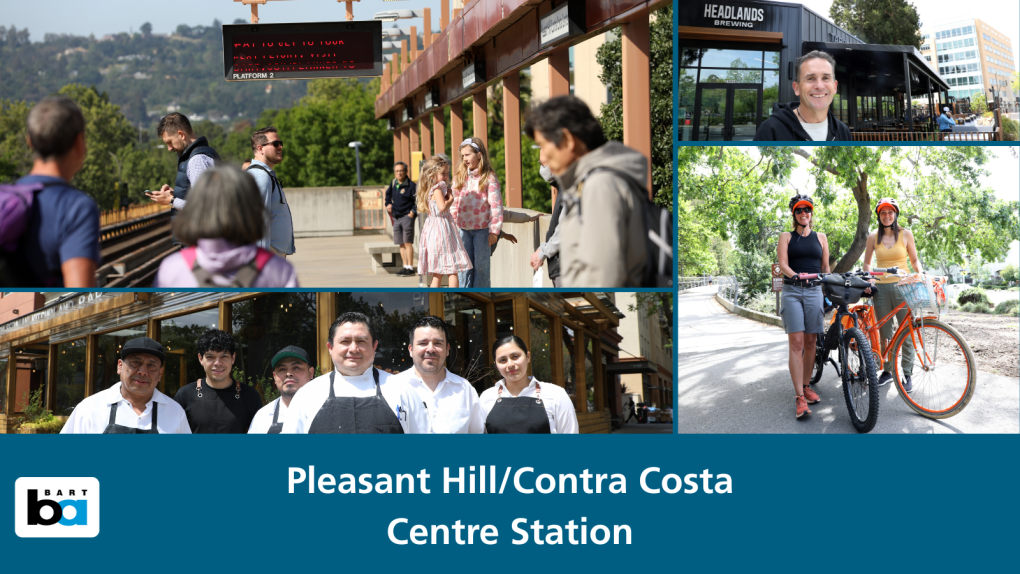
Read more stories and see interactive maps about BART’s impact at bart.gov/impact.
BART's Impact
How do you measure BART's impact on the Bay Area?
You might look at the numbers. In fiscal year 2024, for example, BART contributed an estimated $2.7 billion* in economic activity to the five counties it serves. Another metric: Riders traveled over 750 million miles that same year – that's nearly a billion miles traveled on our tracks!
But other impacts go beyond stats and figures: BART makes people’s lives easier, BART reduces traffic, BART helps the environment. Numbers don't tell the whole story.
So, where to begin? Let's start small.
Case Study: Pleasant Hill/Contra Costa Centre Station
To understand BART’s impact, we will start by looking at a single station – Pleasant Hill/Contra Costa Centre. From this zoomed-in vantage point, we can illustrate how just one station transforms and sustains not just a neighborhood, but a broad community of residents, workers, businesses, travelers, and families.
Pleasant Hill/Contra Costa Centre Station sits at the convergence of Highway 680, the Iron Horse pedestrian and bicycle trail, multiple hotels and office buildings, and a vibrant mixed-use transit village with restaurants, gyms, bars, a dance school, 600-plus apartment complex, the list goes on . The station is the beating heart that enables these resources to exist and prosper. BART stations are not simply destinations -- stops on a line to get you here and there.
BART stations create destinations.
"Locating by a BART station is a great move for businesses. You have in-built customers, who are coming and going from the station, you can increase capacity by not needing a parking lot, and your employees can get to work affordably."
- BART Director Matt Rinn, whose district includes Pleasant Hill/Contra Costa Centre Station.
We connected with local homeowners, small business owners, a commuter, a major hotel chain, restaurants, neighborhood hangouts, and an apartment complex to understand firsthand why BART is essential to their bottom lines and the well-being of their community.
View a larger version of the interactive map by clicking here.
A dream come true for a railroad history museum: The first of 3 legacy BART cars delivered to Western Railway Museum
Friday, August 9, was a thrilling and long-awaited day for the Western Railway Museum (WRM) as the railroad history museum received the first of three decommissioned legacy BART cars for its forthcoming Rapid Transit History Center.
The museum was awarded the three retired cars – an A, B, and C car – following a call for proposals in 2021 that selected eight recipients to receive decommissioned cars (two recipients later declined). BART officially retired its legacy fleet, which carried passengers for more than 50 years since the opening of the system, at a ceremony and final ride in April 2024. All 55 trains in service are now made up of new cars.
BART’s legacy cars have a tremendous sentimental value with passengers in the greater San Francisco Bay Area, and we wanted to ensure the historic vehicles would have a second life, or more accurately, second lives. The chosen six groups will reuse their cars for a multitude of purposes, including a short-term rental in the Sierras, a bike shop and clubhouse for Oakland youth, a dining car with retro arcade games, and more. The Hayward Fire Department picked up their car earlier this year for its new Regional Fire Training Center.
There was one major catch the recipients had to agree to: BART would give the cars to the groups for free, but they had to transport the cars from their temporary home at BART’s Hayward shops to their final destinations.
As you can imagine, moving a 64,000-pound BART car is not something that can be accomplished with your average trailer hitch. It requires a flatbed truck with a yellow “OVERSIZE” banner as well as a crane for getting the car off the bed. Moving just one car costs thousands of dollars.
The Western Railway Museum raised money to make sure they could get the cars to their new temporary home in Car House 3 until their proposed Rapid Transit History Center is completed. The history center will educate the public about BART and its history of innovation. In addition to the three cars, which the public will be able to enter and explore, the center will include displays, videos, a set of wheels from the front of a cab car, third rail equipment, and the antennas that enable the train to pick up power and communicate with train control. In all, the history center will celebrate the "amazing technology of the 'world's first' automated rapid transit system," said Bob Simon, a retired BART Engineering and Operations Manager who sits on the Western Railway Museum's board of directors.
"The creation and implementation of cutting-edge technologies began with BART's visionaires understanding the great challenge to design a new transit concept. They were not unlike the visionaries who went on to build Silicon Valley," he continued, offering his thanks for the support and enthusiasm of BART General Manager Bob Powers, the BART Board of Directors, and the museum's dedicated volunteers and staff.
So what does it take to move a BART car? Western Railway Museum staff found out firsthand on August 9 when they showed up to the Hayward shops with a flatbed truck and helping hands. BART employees prepared for their visit by transferring the car – #1164 – from its holding track (where the soon-to-be-decommissioned legacy cars are held) to the shop bay with a crane.
When the truck arrived from Salazar Heavy Haul – the same company that delivered BART’s Fleet of the Future cars – BART staff hooked the car up to the crane and attempted to load it on the bed. There was an unforeseen problem: The undercar equipment was just a few inches too big for the truck bed, so BART staff had to improvise by removing the battery box and HVAC underneath it. Most decommissioned cars won’t have this problem as they’ll be picked up with the wheels and mounts removed. That wouldn’t do for Western Railway Museum, however.
“They want everything on the cars so they are as authentic as possible,” explained Brian Tsukamoto, BART Manager of Special Projects – Decommissioning. “They’ll be coming back to pick up the battery box and HVAC.”
Once the temporarily modified car was loaded and secured by the highly skilled driver, it was on its way from Hayward to Suisun City up north. A sign in its front window read: “I’m going to the Western Railway Museum.”
At the museum, the team unloaded the car from the truck using a rented crane and used conversion dollies to allow the car, built for BART’s wide gauge, to be maneuvered on their standard-gauge track. Then, using a former Muni work train locomotive, they zig-zagged the car to Car House 3 and unloaded it onto the BART gauge track they built for it. To save on cutting concrete and rebar, a steel rail strap bridge was fabricated to get the car over the car house door foundation and the public walkway to its platform.
The process will soon be repeated with the B and C cars, which the museum is working to schedule with BART staff and Salazar Heavy Haul. We’ll be sharing updates.
Learn more about the Western History Museum here and the Legacy Fleet Decommissioning project here.
Position open on BART Police Citizen Review Board – District 5 (Accepting applications until 08/08/24)
BART will be accepting applications for membership on the BART Police Citizen Review Board (BPCRB) from Monday, July 8, 2024 - Thursday, August 8, 2024. This appointment will be made by BART Director Melissa Hernandez, District 5.
As a volunteer of the BPCRB, members work to increase the public's confidence in BART's policing services by:
- Reviewing, recommending, and monitoring the implementation of changes to police policies, procedures, and practices
- Receiving citizen allegations of on-duty police misconduct
- Advising Board of Directors, General Manager, Independent Police Auditor, and Police Chief
- Participating in recommending appropriate disciplinary action
- Meeting periodically with representatives of the BART Police associations
- Participating in community outreach
Member Qualifications
Members must:
- Reside within Alameda, Contra Costa, San Francisco, or San Mateo counties
- Be fair-minded and objective
- Have demonstrated commitment to community service
- Not be currently employed in a law enforcement capacity, either sworn or non-sworn
- Not be a relative of current or former BART Police Department personnel
- Have no felony convictions
Duration of Service
All appointments to the BPCRB are for a term of two years. There are no term limits.
How to Apply
To learn more about the BPCRB and/or how to apply for appointment, visit our website at bart.gov/about/bod/advisory/crb. Access the digital application here and the print application below.
Please send an email to [email protected] or call (510) 464-6083 with any questions.
Application period closes on Thursday, August 8, 2024
Documents
BPCRB Recruitment Flyer (.doc)
Application for BPCRB - District 5 (.doc)
BPCRB General Information (.doc)
September 1: Join BART for Fairyland’s Big Birthday Party Parade from 19th St. Station
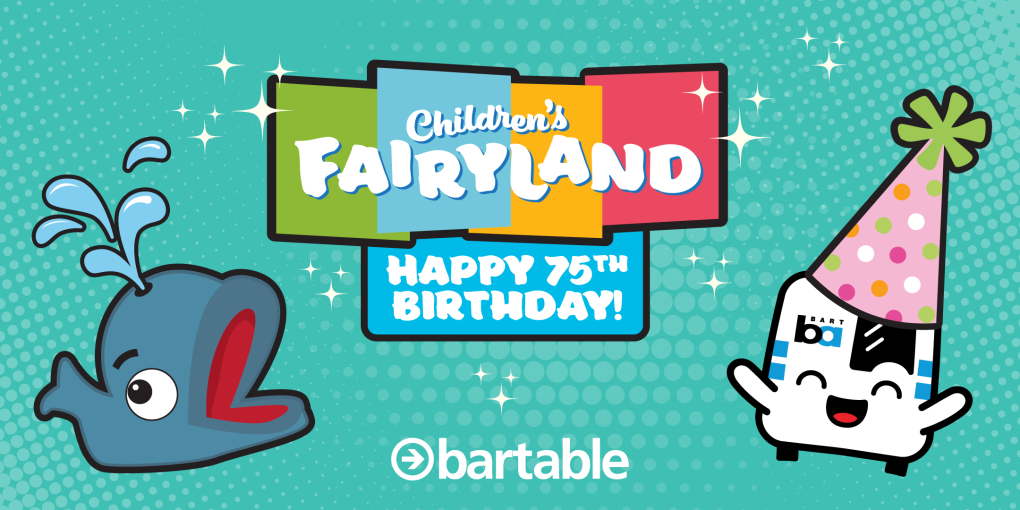
Children’s Fairyland is turning 75, and BART is helping the beloved Oakland institution celebrate!
On Monday, September 1, BART will help kickstart Fairyland’s 75th Birthday Party with a joyful sidewalk parade through the heart of Oakland. Fairyland is a BARTable partner.
Families, friends, neighbors, and community partners will gather at 19th St./Oakland Station at 9:30am and walk together along Broadway, down 21st Street and the Lake Merritt Trail, and end at the front gates of Fairyland just in time for the party to begin.
The BARTmobile will greet paradegoers in front of Fairyland, wearing a special birthday hat and ready for photos with fans. The BART mascot will be surrounded by balloons, a giant rainbow parachute game, circus performers, and more. Once inside, guests will enjoy a full day of activities, entertainment, food, music, and birthday magic.
This short community parade is intended to promote public transit, energize Downtown Oakland, and build excitement for the big birthday bash. AC Transit and the San Francisco Bay Ferry will also be on hand to celebrate.
Everyone is encouraged to ride transit, walk, or roll to the parade. Costumes (and BART swag!), signs, and noisemakers are encouraged.
Please note: The parade is free and open to all, but entry into Fairyland for the 75th Birthday Party requires purchased tickets. All guests must be accompanied by a child to enter the park, unless they are a registered community partner with an activation during the celebration.
Visit Fairyland’s website for more info on what to expect at the birthday party and to purchase tickets in advance. Tickets will be sold at the door.
What: Fairyland’s Big Birthday Party Parade
Time: 9:30am to 10:00am
Start/end: 19th St. Station → Children’s Fairyland front gates
Walk time: About 15 minutes
Let us know you’re coming: BARTFairylandParade.eventbrite.com (RSVPing is optional)
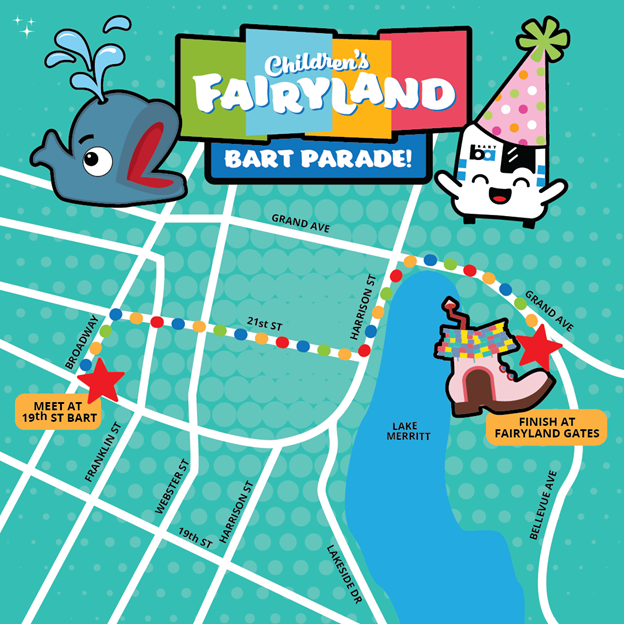
Driving ridership through community partnerships
The Fairyland Big Birthday Party Parade is part of BART Marketing’s efforts to boost ridership and foster stronger ties with local communities through strategic partnerships. BART partners with over 250 local organizations annually, helping to significantly expand the reach of our messaging. These partnerships come at no cost to BART and promote that taking BART is fun, in addition to being convenient, inexpensive, and environmentally friendly.
Since the pandemic, ridership on nights and weekends is growing faster than commute ridership. While people may not be going into the office as often as they used to, they are going to games, shows, museums, and other fun events that can only be experienced in person. Our partnerships lean into this.
Discover more BARTable fun at bart.gov/bartable and check out our Rider Guides page with tips for how to get to local sports and entertainment venues by BART.
Engineers Week 2025: BART engineers on the year’s big projects and why they’re proud to be a part of them

Every year, BART celebrates Engineers Week in recognition of the more than 180 engineers who are committed to imagining and executing the future of the BART system. BART is the Bay Area, and the future of our transportation system is deeply entwined with the future of this region. Our engineers provide us a roadmap for the fast-approaching horizon, reshaping how we experience and interact with our world.
BART is unique in that it’s home to many different engineering disciplines – construction, computer systems, electrical, mechanical, traction power, corrosion, and more! The projects our engineers undertake are like puzzles with hundreds of thousands of pieces, all of which must fit together just right to make a functioning whole. Our engineers’ ingenuity, creativity, and resourcefulness get this tough work done.
The theme of Engineers Week 2025 is Design Your Future – “both a call to action and a celebration of the limitless possibilities in engineering,” writes DiscoverE, which established Engineers Week more than 70 years ago. How far we’ve come!
In 2025, BART engineers are not just “designing” the future, but implementing it. It’s going to be a big year for BART, and so we reached out to the engineers themselves to tell you about some of the exciting projects BART has in store for 2025 and why they’re proud to be a part of it.
And speaking of the future – we're now looking for our 2025 class of engineering interns! Since 2018, BART has hired 15 internship participants as junior engineers, including four from last year’s program – it's a great way to get your foot in the door and gain hands-on, practical engineering experience.
Visit bart.gov/internships for information on eligibility and how to apply.
Next-Generation Fare Gates Project
BART has made the historic purchase of brand-new fare gates to be installed systemwide as part of its latest effort to improve the customer experience and overhaul safety in the system. The new fare gates bring a new look and improved experience, offering state-of-the-art technology that will boost safety by reducing fare evasion, enhancing access for people in wheelchairs and those who bring bikes and strollers on BART, and optimizing the reliability and maintenance needs of the fare gates.
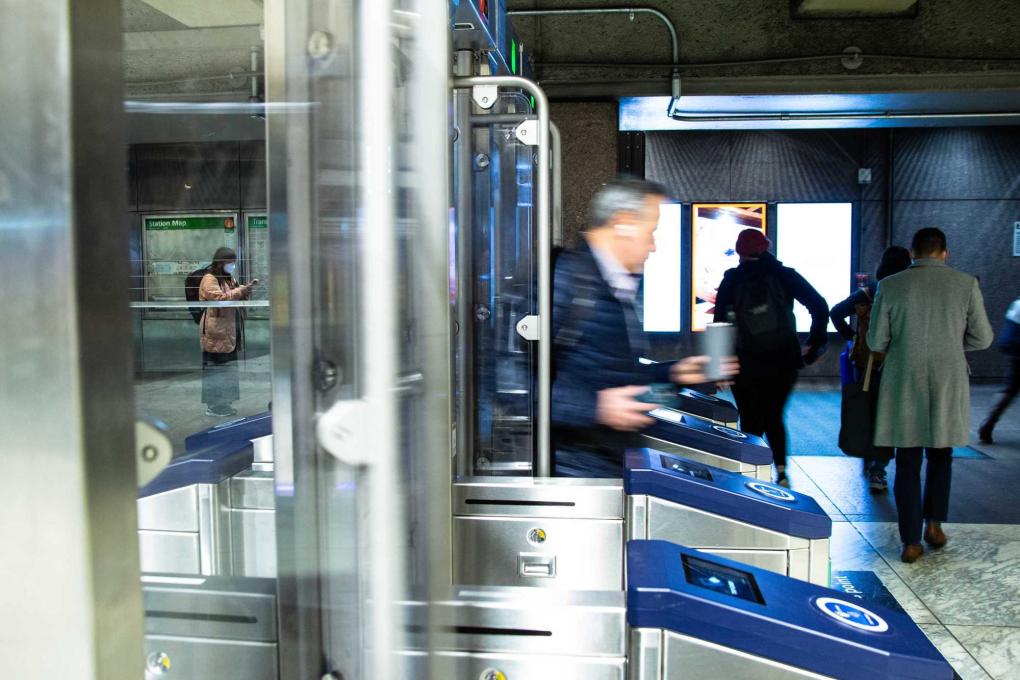
A photo of the new fare gates at Embarcadero Station.
Michael Gerbracht, Senior Manager of Engineering Programs
"Creating an environment where passengers feel safe, comfortable, and are happy to ride our trains is crucial. The fare gates are something that riders from across the Bay Area have been excited to see implemented for years, and it is great to be able to deliver for them.
I am so proud of the way the team – and really the entire District - has stepped up to the challenge of delivering the new fare gates."
John Yen, Manager of Computer Systems Engineering
"The part I am personally proud of is our staff’s ability to stay flexible and adapt to changing project conditions and project complexity. There are a lot of varying site conditions and prep work by multiple disciplines (electrical, communications, buildings, etc.) before the new fare gates can be installed. This project effectively is rolling three projects into one!"
San Francisco Station Escalator and Canopy Project
The San Francisco Station Canopy Project will not only protect new escalators being installed from the wear-and-tear of elements like rain and wind-swept debris, but they will provide an added layer of station security and cleanliness through motorized gates that allow the entrances to be locked at street level when stations are closed. At present, 14 canopies have been completed, and three canopies are under construction, with an additional four canopies to be constructed in the future. The project is happening in concurrence with the San Francisco Station Escalator Replacement Project, which is installing and replacing a total of 45 escalators at Downtown San Francisco stations.
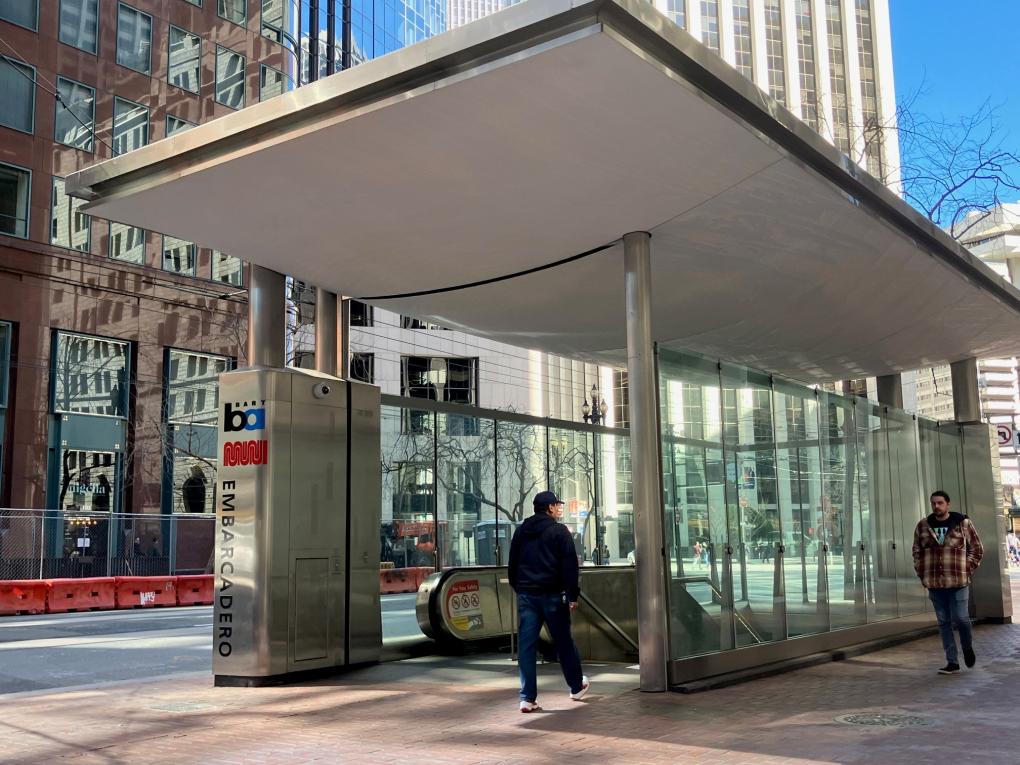
A photo of the new canopy at Embarcadero Station.
David Silva, Project Manager for the Market Street Canopies Project
"In addition to providing weather protection for patrons and escalators, the canopies assist with placemaking, providing easily recognizable entrances to the stations. They also feature real-time displays to provide patrons with train and bus schedule information as well as security features such as improved lighting, cameras, and grilles that secure the entrances at street level at night.
This project requires an enormous amount of coordination. I am very proud of how the entire project team has come together with the invaluable assistance of BART Government and Community Relations to keep the community, including neighboring businesses, rideshare companies, and other stakeholders informed about the project while working to understand and address their concerns."
Elliott Kolto, Principal Mechanical Engineer
"To date, the project has successfully completed the replacement of 17 escalators, with 24 remaining and three to six undergoing replacement at any given time. The new escalators are more modern and reliable with updated safety features, technology, and maintainability.
I am proud to be a part of this project and work with the team of engineers, maintenance, project management, and construction management, who are working so hard together to make this project successful and improve the customer experience."
Traction Power Substation Restoration and Construction
Traction power facilities take incoming power from PG&E and convert it to 1,000 Volts (V) Direct Current (DC) power for BART’s third-rail system. The facilities also monitor, regulate, and ensure safe distribution of power throughout the system. Two new power substations by Civic Center and Montgomery St. Stations will be coming online this year, and another substation east of the Transbay Tube is currently undergoing full renovation. BART is also upgrading and restoring substations, including the Oakland facility mentioned below.
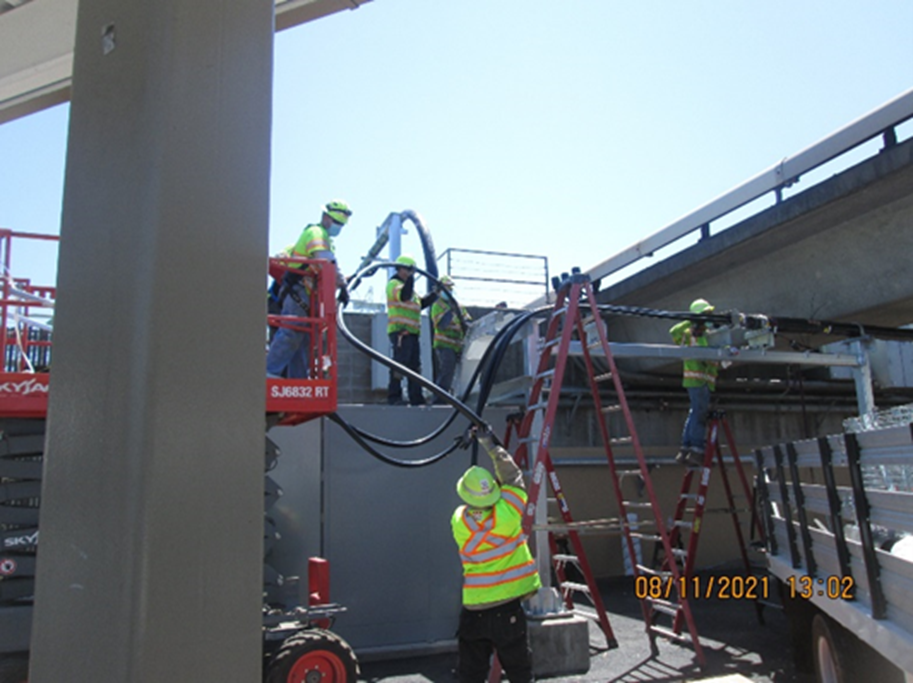
A photo of 34.5kV cable replacement and fiber optic installation between the Coliseum and Union City.
Gordon Wong, Principal Electrical Engineer
"The restoration of Downtown Oakland’s KTT substation, which failed last year after experiencing a fault, allows trains to operate at full speed, reducing delay and transfer times at MacArthur and 19th Street Station.
Having the substation back in service allows for redundancy in the network; there are now multiple substations able to supply power to the area, meaning customers will have a faster, more streamlined experience.
I am proud to work with the dedicated members of engineering and maintenance, who share the common goal of making sure BART is working for those who rely on us."
East Bay Rail Replacement
BART is replacing aging track, among other rebuilding projects that impact reliability, with funding from voter-approved bond Measure RR. The equipment being replaced is decades-old and has outlived its design life.
Engineers on the Yellow Line trackway between Pleasant Hill and Concord stations.
Girish Koli, Senior Manager of Engineering Programs
"I am proud to be part of this project as it improves safety for BART staff and reduces the maintenance burden. It will also enhance customer experience by providing patrons with a smoother and quieter ride.
This project was added to my portfolio last year, and I’ve been amazed to see how much hard work, coordination, and dedication many staff members have devoted to ensuring this is a successful project for BART."
Zeeshan Ali, Division Manager Traction Power Engineering (Interim)
"Traction Power Engineering recently completed several projects that significantly enhance the reliability and safety of BART’s electrical infrastructure. These upgrades offer a more dependable, faster, and safer transit experience for riders across the Bay Area.
I am proud of myself and my team for the contributions we’ve made and continue to make in connecting Bay Area communities."

